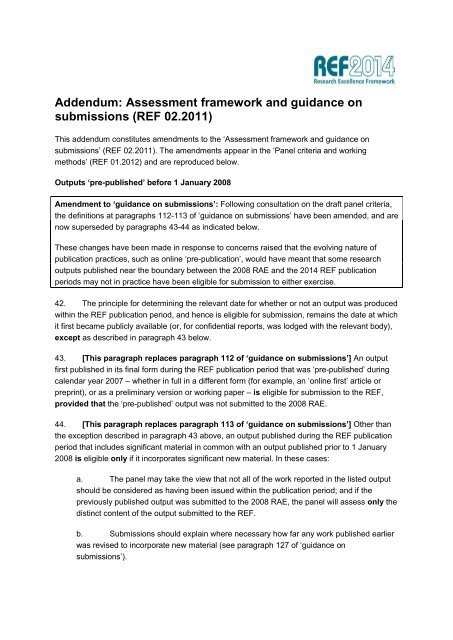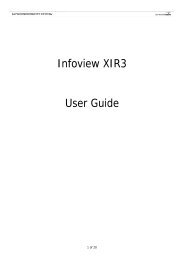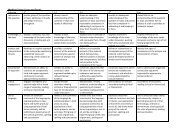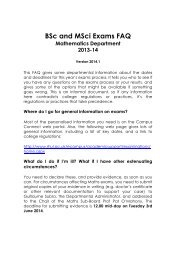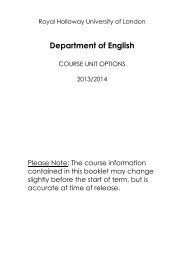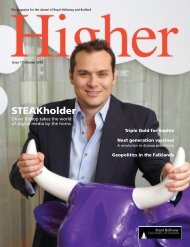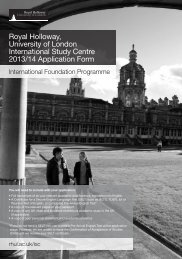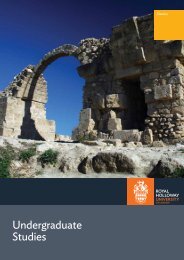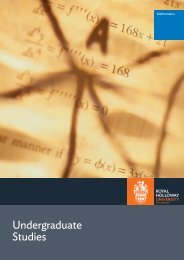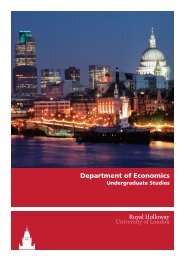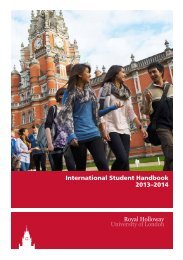Addendum: Assessment framework and guidance on submissions ...
Addendum: Assessment framework and guidance on submissions ...
Addendum: Assessment framework and guidance on submissions ...
Create successful ePaper yourself
Turn your PDF publications into a flip-book with our unique Google optimized e-Paper software.
<str<strong>on</strong>g>Addendum</str<strong>on</strong>g>: <str<strong>on</strong>g>Assessment</str<strong>on</strong>g> <str<strong>on</strong>g>framework</str<strong>on</strong>g> <str<strong>on</strong>g>and</str<strong>on</strong>g> <str<strong>on</strong>g>guidance</str<strong>on</strong>g> <strong>on</strong><br />
submissi<strong>on</strong>s (REF 02.2011)<br />
This addendum c<strong>on</strong>stitutes amendments to the ‘<str<strong>on</strong>g>Assessment</str<strong>on</strong>g> <str<strong>on</strong>g>framework</str<strong>on</strong>g> <str<strong>on</strong>g>and</str<strong>on</strong>g> <str<strong>on</strong>g>guidance</str<strong>on</strong>g> <strong>on</strong><br />
submissi<strong>on</strong>s’ (REF 02.2011). The amendments appear in the ‘Panel criteria <str<strong>on</strong>g>and</str<strong>on</strong>g> working<br />
methods’ (REF 01.2012) <str<strong>on</strong>g>and</str<strong>on</strong>g> are reproduced below.<br />
Outputs ‘pre-published’ before 1 January 2008<br />
Amendment to ‘<str<strong>on</strong>g>guidance</str<strong>on</strong>g> <strong>on</strong> submissi<strong>on</strong>s’: Following c<strong>on</strong>sultati<strong>on</strong> <strong>on</strong> the draft panel criteria,<br />
the definiti<strong>on</strong>s at paragraphs 112-113 of ‘<str<strong>on</strong>g>guidance</str<strong>on</strong>g> <strong>on</strong> submissi<strong>on</strong>s’ have been amended, <str<strong>on</strong>g>and</str<strong>on</strong>g> are<br />
now superseded by paragraphs 43-44 as indicated below.<br />
These changes have been made in resp<strong>on</strong>se to c<strong>on</strong>cerns raised that the evolving nature of<br />
publicati<strong>on</strong> practices, such as <strong>on</strong>line ‘pre-publicati<strong>on</strong>’, would have meant that some research<br />
outputs published near the boundary between the 2008 RAE <str<strong>on</strong>g>and</str<strong>on</strong>g> the 2014 REF publicati<strong>on</strong><br />
periods may not in practice have been eligible for submissi<strong>on</strong> to either exercise.<br />
42. The principle for determining the relevant date for whether or not an output was produced<br />
within the REF publicati<strong>on</strong> period, <str<strong>on</strong>g>and</str<strong>on</strong>g> hence is eligible for submissi<strong>on</strong>, remains the date at which<br />
it first became publicly available (or, for c<strong>on</strong>fidential reports, was lodged with the relevant body),<br />
except as described in paragraph 43 below.<br />
43. [This paragraph replaces paragraph 112 of ‘<str<strong>on</strong>g>guidance</str<strong>on</strong>g> <strong>on</strong> submissi<strong>on</strong>s’] An output<br />
first published in its final form during the REF publicati<strong>on</strong> period that was ‘pre-published’ during<br />
calendar year 2007 – whether in full in a different form (for example, an ‘<strong>on</strong>line first’ article or<br />
preprint), or as a preliminary versi<strong>on</strong> or working paper – is eligible for submissi<strong>on</strong> to the REF,<br />
provided that the ‘pre-published’ output was not submitted to the 2008 RAE.<br />
44. [This paragraph replaces paragraph 113 of ‘<str<strong>on</strong>g>guidance</str<strong>on</strong>g> <strong>on</strong> submissi<strong>on</strong>s’] Other than<br />
the excepti<strong>on</strong> described in paragraph 43 above, an output published during the REF publicati<strong>on</strong><br />
period that includes significant material in comm<strong>on</strong> with an output published prior to 1 January<br />
2008 is eligible <strong>on</strong>ly if it incorporates significant new material. In these cases:<br />
a. The panel may take the view that not all of the work reported in the listed output<br />
should be c<strong>on</strong>sidered as having been issued within the publicati<strong>on</strong> period; <str<strong>on</strong>g>and</str<strong>on</strong>g> if the<br />
previously published output was submitted to the 2008 RAE, the panel will assess <strong>on</strong>ly the<br />
distinct c<strong>on</strong>tent of the output submitted to the REF.<br />
b. Submissi<strong>on</strong>s should explain where necessary how far any work published earlier<br />
was revised to incorporate new material (see paragraph 127 of ‘<str<strong>on</strong>g>guidance</str<strong>on</strong>g> <strong>on</strong><br />
submissi<strong>on</strong>s’).
Staff <str<strong>on</strong>g>and</str<strong>on</strong>g> individual staff circumstances<br />
Amendment to ‘<str<strong>on</strong>g>guidance</str<strong>on</strong>g> <strong>on</strong> submissi<strong>on</strong>s’: Following c<strong>on</strong>sultati<strong>on</strong> <strong>on</strong> the draft panel criteria,<br />
the arrangements c<strong>on</strong>cerning maternity, paternity <str<strong>on</strong>g>and</str<strong>on</strong>g> adopti<strong>on</strong> leave in ‘<str<strong>on</strong>g>guidance</str<strong>on</strong>g> <strong>on</strong><br />
submissi<strong>on</strong>s’ have been amended, <str<strong>on</strong>g>and</str<strong>on</strong>g> are now superseded by the <str<strong>on</strong>g>guidance</str<strong>on</strong>g> as stated below.<br />
For completeness, the full set of arrangements c<strong>on</strong>cerning individual staff circumstances are set<br />
out in paragraphs 64-91 of this document, which replace paragraphs 88-95 of ‘<str<strong>on</strong>g>guidance</str<strong>on</strong>g> <strong>on</strong><br />
submissi<strong>on</strong>s’.<br />
63. The criteria for determining which staff are eligible to be included in instituti<strong>on</strong>s’<br />
submissi<strong>on</strong>s are comm<strong>on</strong> for all UOAs, <str<strong>on</strong>g>and</str<strong>on</strong>g> are set out in ‘<str<strong>on</strong>g>guidance</str<strong>on</strong>g> <strong>on</strong> submissi<strong>on</strong>s’ (paragraphs<br />
78-83).<br />
64. Up to four research outputs must be listed against each member of staff included in the<br />
submissi<strong>on</strong>. A maximum of four outputs per researcher will provide panels with a sufficient<br />
selecti<strong>on</strong> of research outputs from each submitted unit up<strong>on</strong> which to base judgements about the<br />
quality of that unit’s outputs. C<strong>on</strong>sultati<strong>on</strong>s <strong>on</strong> the development of the REF c<strong>on</strong>firmed that this is<br />
an appropriate maximum volume of research outputs for the purposes of assessment.<br />
65. As a key measure to support equality <str<strong>on</strong>g>and</str<strong>on</strong>g> diversity in research careers, in all UOAs<br />
individuals may be returned with fewer than four outputs without penalty in the assessment,<br />
where their individual circumstances have significantly c<strong>on</strong>strained their ability to produce four<br />
outputs or to work productively throughout the assessment period. This measure is intended to<br />
encourage instituti<strong>on</strong>s to submit all their eligible staff who have produced excellent research.<br />
66. HEIs are allowed to list the maximum of four outputs against any researcher, irrespective<br />
of their circumstances or the length of time they have had to c<strong>on</strong>duct research. A minimum of<br />
<strong>on</strong>e output must be listed against each individual submitted to the REF.<br />
67. In order to provide clarity <str<strong>on</strong>g>and</str<strong>on</strong>g> c<strong>on</strong>sistency <strong>on</strong> the number of outputs that may be reduced<br />
without penalty, there will be a clearly defined reducti<strong>on</strong> in outputs for those types of<br />
circumstances listed at paragraph 69a. Circumstances that are more complex will require a<br />
judgement about the appropriate reducti<strong>on</strong> in outputs; these are listed at paragraph 69b.<br />
Arrangements have been put in place for complex circumstances to be c<strong>on</strong>sidered <strong>on</strong> a<br />
c<strong>on</strong>sistent basis, as described at paragraphs 88-91.<br />
68. Where an individual is submitted with fewer than four outputs <str<strong>on</strong>g>and</str<strong>on</strong>g> they do not satisfy the<br />
criteria described at paragraphs 69-91 below, any ‘missing’ outputs will be graded as<br />
‘unclassified’.<br />
69. Category A <str<strong>on</strong>g>and</str<strong>on</strong>g> C staff may be returned with fewer than four outputs without penalty in<br />
the assessment, if <strong>on</strong>e or more of the following circumstances significantly c<strong>on</strong>strained their<br />
ability to produce four outputs or to work productively throughout the assessment period:<br />
a. Circumstances with a clearly defined reducti<strong>on</strong> in outputs, which are:<br />
i. Qualifying as an early career researcher (<strong>on</strong> the basis set out in paragraph 72<br />
<str<strong>on</strong>g>and</str<strong>on</strong>g> Table 1 below).
ii. Absence from work due to working part-time, sec<strong>on</strong>dments or career breaks<br />
(<strong>on</strong> the basis set out in paragraphs 73-74 <str<strong>on</strong>g>and</str<strong>on</strong>g> Table 2 below).<br />
iii. Qualifying periods of maternity, paternity or adopti<strong>on</strong> leave (<strong>on</strong> the basis set<br />
out in paragraphs 75-81).<br />
iv. Other circumstances that apply in UOAs 1-6, as defined at paragraph 86.<br />
b. Complex circumstances that require a judgement about the appropriate<br />
reducti<strong>on</strong> in outputs, which are:<br />
i. Disability. This is defined in ‘<str<strong>on</strong>g>guidance</str<strong>on</strong>g> <strong>on</strong> submissi<strong>on</strong>s’ Part 4, Table 2 under<br />
‘Disability’.<br />
ii.<br />
iii.<br />
Ill health or injury.<br />
Mental health c<strong>on</strong>diti<strong>on</strong>s.<br />
iv. C<strong>on</strong>straints relating to pregnancy, maternity, paternity, adopti<strong>on</strong> or childcare<br />
that fall outside of – or justify the reducti<strong>on</strong> of further outputs in additi<strong>on</strong> to – the<br />
allowances made in paragraph 75 below.<br />
v. Other caring resp<strong>on</strong>sibilities (such as caring for an elderly or disabled family<br />
member).<br />
vi.<br />
Gender reassignment.<br />
vii. Other circumstances relating to the protected characteristics listed at<br />
paragraph 190 of ‘<str<strong>on</strong>g>guidance</str<strong>on</strong>g> of submissi<strong>on</strong>s’ or relating to activities protected by<br />
employment legislati<strong>on</strong>.<br />
Clearly defined circumstances<br />
70. Where an individual has <strong>on</strong>e or more circumstances with a clearly defined reducti<strong>on</strong> in<br />
outputs, the number of outputs that may be reduced should be determined according to the<br />
tables <str<strong>on</strong>g>and</str<strong>on</strong>g> <str<strong>on</strong>g>guidance</str<strong>on</strong>g> in paragraphs 72-86 below. All sub-panels will accept a reducti<strong>on</strong> in outputs<br />
according to this <str<strong>on</strong>g>guidance</str<strong>on</strong>g> <str<strong>on</strong>g>and</str<strong>on</strong>g> will assess the remaining number of submitted outputs without<br />
any penalty.<br />
71. In REF1b, submissi<strong>on</strong>s must include sufficient details of the individual’s circumstances to<br />
show that these criteria have been applied correctly. The panel secretariat will examine the<br />
informati<strong>on</strong> in the first instance <str<strong>on</strong>g>and</str<strong>on</strong>g> advise the sub-panels <strong>on</strong> whether sufficient informati<strong>on</strong> has<br />
been provided <str<strong>on</strong>g>and</str<strong>on</strong>g> the <str<strong>on</strong>g>guidance</str<strong>on</strong>g> applied correctly. The panel secretariat will be trained to provide<br />
such advice, <strong>on</strong> a c<strong>on</strong>sistent basis across all UOAs. Where the sub-panel judges that the criteria<br />
have not been met, the ‘missing’ output(s) will be recorded as unclassified. (For example, an<br />
individual became an early career researcher in January 2011 but <strong>on</strong>ly <strong>on</strong>e output is submitted<br />
rather than two. In this case the submitted output will be assessed, <str<strong>on</strong>g>and</str<strong>on</strong>g> the ‘missing’ output<br />
recorded as unclassified.)
Early career researchers<br />
72. Early career researchers are defined in paragraphs 85-86 of ‘<str<strong>on</strong>g>guidance</str<strong>on</strong>g> <strong>on</strong> submissi<strong>on</strong>s’.<br />
Table 1 sets out the permitted reducti<strong>on</strong> in outputs without penalty in the assessment for early<br />
career researchers who meet this definiti<strong>on</strong>.<br />
Table 1 Early career researchers: permitted reducti<strong>on</strong> in outputs<br />
Date at which the individual first met the REF<br />
definiti<strong>on</strong> of an early career researcher:<br />
Number of outputs may<br />
be reduced by up to:<br />
On or before 31 July 2009 0<br />
Between 1 August 2009 <str<strong>on</strong>g>and</str<strong>on</strong>g> 31 July 2010 inclusive 1<br />
Between 1 August 2010 <str<strong>on</strong>g>and</str<strong>on</strong>g> 31 July 2011 inclusive 2<br />
On or after 1 August 2011 3<br />
Absence from work due to part-time working, sec<strong>on</strong>dments or career breaks<br />
73. Table 2 sets out the permitted reducti<strong>on</strong> in outputs without penalty in the assessment for<br />
absence from work due to:<br />
a. part-time working<br />
b. sec<strong>on</strong>dments or career breaks outside of the higher educati<strong>on</strong> sector, <str<strong>on</strong>g>and</str<strong>on</strong>g> in<br />
which the individual did not undertake academic research.<br />
Table 2 Part-time working, sec<strong>on</strong>dments or career breaks: permitted reducti<strong>on</strong> in outputs<br />
Total m<strong>on</strong>ths absent between 1 January 2008 <str<strong>on</strong>g>and</str<strong>on</strong>g><br />
31 October 2013 due to working part-time,<br />
sec<strong>on</strong>dment or career break:<br />
Number of outputs may<br />
be reduced by up to:<br />
0-11.99 0<br />
12-27.99 1<br />
28-45.99 2<br />
46 or more 3<br />
74. The allowances in Table 2 are based <strong>on</strong> the length of the individual’s absence or time<br />
away from working in higher educati<strong>on</strong>. They are defined in terms of total m<strong>on</strong>ths absent from<br />
work. For part-time working, the equivalent ‘total m<strong>on</strong>ths absent’ should be calculated by
multiplying the number of m<strong>on</strong>ths worked part-time by the full-time equivalent (FTE) not worked<br />
during those m<strong>on</strong>ths. For example, an individual worked part-time for 30 m<strong>on</strong>ths at 0.6 FTE. The<br />
number of equivalent m<strong>on</strong>ths absent = 30 x 0.4 = 12.<br />
Qualifying periods of maternity, paternity or adopti<strong>on</strong> leave<br />
75. Individuals may reduce the number of outputs by <strong>on</strong>e, for each discrete period of:<br />
a. Statutory maternity leave or statutory adopti<strong>on</strong> leave taken substantially during<br />
the period 1 January 2008 to 31 October 2013, regardless of the length of the leave.<br />
b. Additi<strong>on</strong>al paternity or adopti<strong>on</strong> leave 1 lasting for four m<strong>on</strong>ths or more, taken<br />
substantially during the period 1 January 2008 to 31 October 2013.<br />
76. The approach to these circumstances is based <strong>on</strong> the funding bodies’ c<strong>on</strong>sidered<br />
judgement that the impact of such a period of leave <str<strong>on</strong>g>and</str<strong>on</strong>g> the arrival of a new child into a family is<br />
generally sufficiently disruptive of an individual’s research work to justify the reducti<strong>on</strong> of an<br />
output. This judgement was informed by the c<strong>on</strong>sultati<strong>on</strong> <strong>on</strong> draft panel criteria, in which an<br />
overwhelming majority of resp<strong>on</strong>dents supported such an approach.<br />
77. The funding bodies’ decisi<strong>on</strong> not to have a minimum qualifying period for maternity leave<br />
was informed by the sector’s clear support for this approach in the c<strong>on</strong>sultati<strong>on</strong>; recogniti<strong>on</strong> of<br />
the potential physical implicati<strong>on</strong>s of pregnancy <str<strong>on</strong>g>and</str<strong>on</strong>g> childbirth; <str<strong>on</strong>g>and</str<strong>on</strong>g> the intenti<strong>on</strong> to remove any<br />
artificial barriers to the inclusi<strong>on</strong> of women in submissi<strong>on</strong>s, given that women were significantly<br />
less likely to be selected in former RAE exercises.<br />
78. The funding bodies c<strong>on</strong>sider it appropriate to make the same provisi<strong>on</strong> for those<br />
regarded as the ‘primary adopter’ of a child (that is, a pers<strong>on</strong> who takes statutory adopti<strong>on</strong><br />
leave), as the adopti<strong>on</strong> of a child <str<strong>on</strong>g>and</str<strong>on</strong>g> taking of statutory adopti<strong>on</strong> leave is generally likely to have<br />
a comparable impact <strong>on</strong> a researcher’s work to that of taking maternity leave.<br />
79. As regards additi<strong>on</strong>al paternity or adopti<strong>on</strong> leave, researchers who take such leave will<br />
also have been away from work <str<strong>on</strong>g>and</str<strong>on</strong>g> acting as the primary carer of a new child within a family.<br />
The funding bodies c<strong>on</strong>sider that where researchers take such leave over a significant period<br />
(four m<strong>on</strong>ths or more), this is likely to have an impact <strong>on</strong> their ability to work productively <strong>on</strong><br />
research that is comparable to the impact <strong>on</strong> those taking maternity or statutory adopti<strong>on</strong> leave.<br />
80. While the clearly defined reducti<strong>on</strong> of outputs due to additi<strong>on</strong>al paternity or adopti<strong>on</strong><br />
leave is subject to a minimum period of four m<strong>on</strong>ths, shorter periods of such leave can be taken<br />
into account as follows:<br />
1 ‘Additi<strong>on</strong>al paternity or adopti<strong>on</strong> leave’ refers to leave of up to 26 weeks which is taken to care for a child where<br />
the pers<strong>on</strong>’s spouse, partner or civil partner was entitled to statutory maternity leave or statutory adopti<strong>on</strong> leave,<br />
<str<strong>on</strong>g>and</str<strong>on</strong>g> has since returned to work. The term ‘additi<strong>on</strong>al paternity leave’ is often used to describe this type of leave<br />
although it may be taken by parents of either gender. For the purposes of the REF we refer to this leave as<br />
‘additi<strong>on</strong>al paternity or adopti<strong>on</strong> leave’.
a. By seeking a reducti<strong>on</strong> in outputs under the provisi<strong>on</strong> for complex circumstances,<br />
for example where the period of leave had an impact in combinati<strong>on</strong> with other factors<br />
such as <strong>on</strong>going childcare resp<strong>on</strong>sibilities.<br />
b. By combining the number of m<strong>on</strong>ths for shorter periods of such leave in<br />
combinati<strong>on</strong> with other clearly defined circumstances, according to Table 2.<br />
81. Any period of maternity, adopti<strong>on</strong> or paternity leave that qualifies for the reducti<strong>on</strong> of an<br />
output under the provisi<strong>on</strong>s in paragraph 75 above may in individual cases be associated with<br />
prol<strong>on</strong>ged c<strong>on</strong>straints <strong>on</strong> work that justify the reducti<strong>on</strong> of more than <strong>on</strong>e output. In such cases,<br />
the circumstances should be explained using the arrangements for complex circumstances.<br />
Combining clearly defined circumstances<br />
82. Where individuals have had a combinati<strong>on</strong> of circumstances with clearly defined<br />
reducti<strong>on</strong>s in outputs, these may be accumulated up to a maximum reducti<strong>on</strong> of three outputs.<br />
For each circumstance, the relevant reducti<strong>on</strong> should be applied <str<strong>on</strong>g>and</str<strong>on</strong>g> added together to calculate<br />
the total maximum reducti<strong>on</strong>.<br />
83. Where Table 1 is combined with Table 2, the period of time since 1 January 2008 up until<br />
the individual met the definiti<strong>on</strong> of an early career researcher should be calculated in m<strong>on</strong>ths,<br />
<str<strong>on</strong>g>and</str<strong>on</strong>g> Table 2 should be applied.<br />
84. When combining circumstances, <strong>on</strong>ly <strong>on</strong>e circumstance should be taken into account for<br />
any period of time during which they took place simultaneously. (For example, an individual<br />
worked part-time throughout the assessment period <str<strong>on</strong>g>and</str<strong>on</strong>g> first met the definiti<strong>on</strong> of an early career<br />
researcher <strong>on</strong> 1 September 2009. In this case the number of m<strong>on</strong>ths ‘absent’ due to part-time<br />
working should be calculated from 1 September 2009 <strong>on</strong>wards, <str<strong>on</strong>g>and</str<strong>on</strong>g> combined with the reducti<strong>on</strong><br />
due to qualifying as an early career researcher, as indicated in paragraph 83 above.)<br />
85. Where an individual has a combinati<strong>on</strong> of circumstances with a clearly defined reducti<strong>on</strong><br />
in outputs <str<strong>on</strong>g>and</str<strong>on</strong>g> complex circumstances, the instituti<strong>on</strong> should submit these collectively as<br />
‘complex’ so that a single judgement can be made about the appropriate reducti<strong>on</strong> in outputs,<br />
taking into account all the circumstances. Those circumstances with a clearly defined reducti<strong>on</strong><br />
in outputs should be calculated according to the <str<strong>on</strong>g>guidance</str<strong>on</strong>g> above (paragraphs 72-84).<br />
Other circumstances that apply in UOAs 1-6<br />
86. In UOAs 1-6, the number of outputs may be reduced by up to two, without penalty in the<br />
assessment, for the following:<br />
a. Category A staff who are junior clinical academics. These are defined as clinically<br />
qualified academics who are still completing their clinical training in medicine or dentistry<br />
<str<strong>on</strong>g>and</str<strong>on</strong>g> have not gained a Certificate of Completi<strong>on</strong> of Training (CCT) or its equivalent prior to<br />
31 October 2013.
. Category C staff who are employed primarily as clinical, health or veterinary<br />
professi<strong>on</strong>als (for example by the NHS), <str<strong>on</strong>g>and</str<strong>on</strong>g> whose research is primarily focused in the<br />
submitting unit.<br />
87. These allowances are made <strong>on</strong> the basis that the staff c<strong>on</strong>cerned are normally<br />
significantly c<strong>on</strong>strained in the time they have available to undertake research during the<br />
assessment period. The reducti<strong>on</strong> of two outputs takes account of significant c<strong>on</strong>straints <strong>on</strong><br />
research work, <str<strong>on</strong>g>and</str<strong>on</strong>g> is normally sufficient to also take account of additi<strong>on</strong>al circumstances that<br />
may have affected the individual’s research work. Where the individual meets the criteria at<br />
paragraph 86, <str<strong>on</strong>g>and</str<strong>on</strong>g> has had significant additi<strong>on</strong>al circumstances – for any of the reas<strong>on</strong>s at<br />
paragraph 69 – the instituti<strong>on</strong> may return the circumstances as ‘complex’ with a reducti<strong>on</strong> of<br />
three outputs, <str<strong>on</strong>g>and</str<strong>on</strong>g> provide a justificati<strong>on</strong> for this.<br />
Complex circumstances<br />
88. Where staff have had <strong>on</strong>e or more complex circumstances – including in combinati<strong>on</strong><br />
with any circumstances with a clearly defined reducti<strong>on</strong> in outputs – the instituti<strong>on</strong> will need to<br />
make a judgement <strong>on</strong> the appropriate reducti<strong>on</strong> in the number of outputs submitted, <str<strong>on</strong>g>and</str<strong>on</strong>g> provide<br />
a rati<strong>on</strong>ale for this judgement.<br />
89. As far as is practicable, the informati<strong>on</strong> in REF1b should provide an estimate – in terms<br />
of the equivalent number of m<strong>on</strong>ths absent from work – of the impact of the complex<br />
circumstances <strong>on</strong> the individual’s ability to work productively throughout the assessment period,<br />
<str<strong>on</strong>g>and</str<strong>on</strong>g> state any further c<strong>on</strong>straints <strong>on</strong> the individual’s research work in additi<strong>on</strong> to the equivalent<br />
m<strong>on</strong>ths absent. A reducti<strong>on</strong> should be made according to Table 2 in relati<strong>on</strong> to estimated m<strong>on</strong>ths<br />
absent from work, with further c<strong>on</strong>straints taken into account as appropriate. To aid instituti<strong>on</strong>s<br />
the Equality Challenge Unit (ECU) will publish worked examples of complex circumstances,<br />
which will indicate how these calculati<strong>on</strong>s can be made <str<strong>on</strong>g>and</str<strong>on</strong>g> the appropriate reducti<strong>on</strong> in outputs<br />
for a range of complex circumstances. These will be available at www.ecu.ac.uk/ourprojects/REF<br />
from February 2012.<br />
90. All submitted complex circumstances will be c<strong>on</strong>sidered by the REF Equality <str<strong>on</strong>g>and</str<strong>on</strong>g><br />
Diversity Advisory Panel (EDAP), <strong>on</strong> a c<strong>on</strong>sistent basis across all UOAs. The membership <str<strong>on</strong>g>and</str<strong>on</strong>g><br />
terms of reference of the EDAP are available at www.ref.ac.uk under Equality <str<strong>on</strong>g>and</str<strong>on</strong>g> diversity. The<br />
EDAP will make recommendati<strong>on</strong>s about the appropriate number of outputs that may be reduced<br />
without penalty to the relevant main panel chairs, who will make the decisi<strong>on</strong>s. The relevant subpanels<br />
will then be informed of the decisi<strong>on</strong>s <str<strong>on</strong>g>and</str<strong>on</strong>g> will assess the remaining outputs without any<br />
penalty.<br />
91. To enable individuals to disclose the informati<strong>on</strong> in a c<strong>on</strong>fidential manner, informati<strong>on</strong><br />
submitted about individuals’ complex circumstances will be kept c<strong>on</strong>fidential to the REF team,<br />
the EDAP <str<strong>on</strong>g>and</str<strong>on</strong>g> main panel chairs, <str<strong>on</strong>g>and</str<strong>on</strong>g> will be destroyed <strong>on</strong> completi<strong>on</strong> of the REF (as described<br />
in ‘<str<strong>on</strong>g>guidance</str<strong>on</strong>g> <strong>on</strong> submissi<strong>on</strong>s’, paragraphs 98-99).


